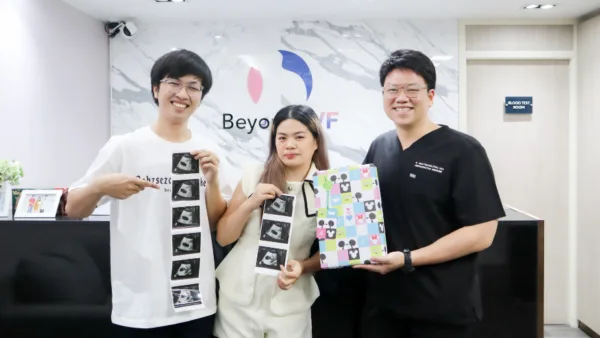ICSI Success Story: Achieving Pregnancy on the Second Embryo Transfer with Dr. Ton’s Endometrial Preparation
ICSI Success Story: A Mother of Two Expands Her Family with Beyond IVF
This case involves a 31-year-old mother of two who wished to have another baby. Despite trying for quite some time, she was unable to conceive naturally. Wanting to expand her family as soon as possible, she began researching IVF treatments and decided to consult with Dr. Ton Poonsak at Beyond IVF. She was drawn to the clinic after reading success stories and reviews, as well as learning about Dr. Ton’s 20+ years of expertise in treating infertility.
After an initial consultation and comprehensive health check, the results revealed that the patient had endometrial issues. However, Dr. Ton assured her that pregnancy was still possible through ICSI (Intracytoplasmic Sperm Injection). The patient proceeded with treatment, starting ovarian stimulation and completing 10 days of injections before undergoing egg retrieval.
During the procedure, 25 eggs were successfully collected and fertilized in the lab. Out of these, 10 embryos developed to the blastocyst stage (Day 5 embryos), but not all were of optimal quality. To ensure the best chances of success, Dr. Ton recommended NGS (Next-Generation Sequencing) to screen for chromosomal abnormalities. The results showed that all 10 embryos had normal chromosomal structures, giving the patient the freedom to select any of them for transfer.
Since endometrial health was identified as a concern, preparing the uterine lining was a crucial step before the embryo transfer. As the patient wished to proceed with the transfer in the next cycle, Dr. Ton prescribed medication to optimize the endometrial lining. Additionally, he incorporated "Embryo Glue", a specialized technique used at Beyond IVF, to enhance the chances of implantation and increase the likelihood of a successful pregnancy.
However, an unexpected setback occurred after the first embryo transfer. Fifteen days post-transfer, the HCG level was less than 2 mIU/ml, indicating that the implantation had not been successful. An ultrasound confirmed the absence of a gestational sac. Dr. Ton promptly scheduled a follow-up consultation to investigate the possible causes and explore new treatment strategies.
For the second embryo transfer, Dr. Ton carefully adjusted the patient’s hormone levels to address any deficiencies and prescribed a three-month course of endometrial-repair supplements to further enhance the uterine lining's receptivity.
After three months of dedicated recovery following Dr. Ton’s customized hormonal adjustments and vitamin regimen, another comprehensive health check revealed a significantly improved uterine lining, making it the perfect time for the next embryo transfer. Once again, the "Embryo Glue" technique was utilized to support implantation.
Fifteen days after the second transfer, the HCG levels soared beyond 1,000 mIU/ml. To confirm the pregnancy, Dr. Ton conducted an ultrasound three days later, and this time, a healthy gestational sac was clearly visible—a moment of pure joy for the patient. She had previously assumed that having two children naturally meant conceiving again would be easy. However, this journey made her realize that without ICSI, advanced embryo selection through NGS, and Dr. Ton’s specialized treatment plan, conceiving again might not have been possible.
Treatment Plan: ICSI at Beyond IVF
ICSI (Intracytoplasmic Sperm Injection) – A specialized technique that injects sperm directly into the egg to enhance fertilization success.
NGS (Next-Generation Sequencing) – A genetic screening method to ensure the embryo has the correct number of chromosomes.
Patient Testimonial
"Dr. Ton is truly exceptional! I almost lost hope after the first attempt failed, but he explained everything so clearly that I felt confident to try again. Now, I am beyond happy to have successfully conceived another baby. To all the mothers struggling with infertility, I highly recommend Beyond IVF. The entire team is incredibly supportive, professional, and kind."


